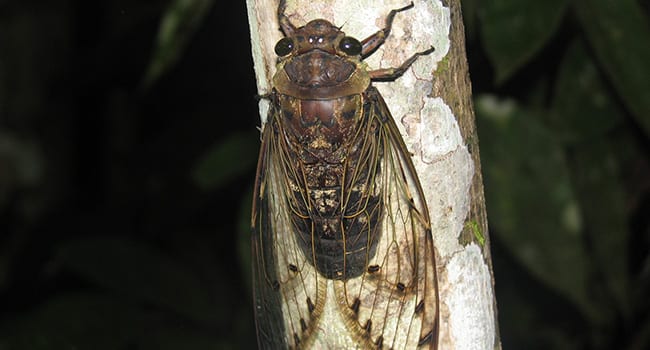
The Cicada’s song – a mating call – is produced by a complex vibrating membrane on their sides and a hollow resonant body cavity
 Every year in late June to mid-July, I await the return of the cicada. (Actually, they never left, but more on that in a moment.) For me, this is the song of summer. As I write, one is serenading me outside my office window.
Every year in late June to mid-July, I await the return of the cicada. (Actually, they never left, but more on that in a moment.) For me, this is the song of summer. As I write, one is serenading me outside my office window.
Long after the April rains have passed, May flowers have bloomed and birds have started their nesting cycles, the cicada starts its courtship song.
You all know it – a long insect-like buzz that emerges from the trees, ventriloquial and resonant. Around the world, it’s perhaps the most recognized insect song.
The song is produced by a complex vibrating membrane on their sides and a hollow resonant body cavity.
The buzzing is a mating call. The singing attracts males and females to a certain area, where the males join in on the chorus and the females choose their mates.
Thousands of them emerge at the same time each year. According to the National Oceanographic and Atmospheric Administration, the emergence is linked to soil temperature. When the soil (at a depth of about 20 cm or eight inches) reaches about 18C (64F), the nymphs emerge and molt into adults to start the breeding cycle.
As a kid, I searched for these critters but seldom found them. There are cryptic in colour, superbly camouflaged and oh so secretive.
There are perhaps 2,500 to 3,000 species of cicada around the world – all are similar in appearance, but very adaptive in where and how they live. While most are about an inch long, the largest species has a wingspan of almost eight inches.
Some can tolerate freezing temperatures, while others thrive only in tropical zones.
Despite the fact they look almost exactly like house flies, they surprisingly aren’t related at all. Rather they’re most closely associated with leaf hoppers and spittlebugs – bizarre bugs with bizarre habits.
The female cicada lays her eggs in slits she cuts in the bark of trees. When the eggs hatch in six to 10 weeks, the tiny cicada larvae drop to the ground and burrow deep beneath the soil.
They spend several months to several years in the soil, feeding on the juices of plant roots. They will molt several times, growing larger each time. While most emerge in two or three years, some species stay underground for up to 17 years!
When ready to emerge as adults, they dig a tunnel to the surface and use this as their portal to the world above. Here they will breed and feed as adults (primarily on tree sap) and then die.
It’s said they’re harmless, but I know from experience that the larger species, such as those found in Borneo, have claw-like feet that can grip your skin rather firmly.
And some species can produce sounds loud enough to cause permanent hearing damage.
For the most part, though, cicadas are innocuous and harmless. They’re a vibrant part of our lives and, for me at least, an essential part of summer.
Geoff Carpentier is a published author, expedition guide and environmental consultant. Visit Geoff online at www.avocetnatureservices.com, on LinkedIn and on Facebook.
The views, opinions and positions expressed by columnists and contributors are the author’s alone. They do not inherently or expressly reflect the views, opinions and/or positions of our publication.

